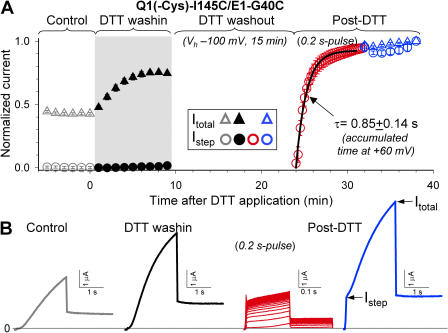XB-IMG-122955
Xenbase Image ID: 122955

|
Figure 8. Estimating the rate of disulfide bond formation between Q1 I145C and E1 40C after DTT treatment. The experiment is divided into four phases. During the control and DTT (10 mM) washin phases, the membrane voltage is stepped from Vh −100 to +60 mV for 2 s and then to −60 mV for 2 s once every 60 s. The current amplitude at the beginning and end of the step to +60 mV (Istep and Itotal, respectively) are monitored. After the DTT effects reach a steady state, the DTT washout phase begins during which the membrane is held at −100 mV for 15 min without depolarizing pulses. Then the ‘post-DTT’ phase begins that consists of two parts. During the first part, short (0.2 s) pulses to +60 mV applied once every 15 s are used to monitor the development of the constitutive component as indicated by the increase in Istep. Once the constitutive component reaches a steady state, the voltage clamp protocol is switched back to the 2-s depolarization pulses applied once every 60 s (as described above) to monitor the stability of Itotal and Istep. (A) Average time course of changes in Itotal and Istep. Data are pooled from four experiments. In each experiment, the amplitudes of Itotal and Istep are normalized by their final values at the end of the experiment to allow data averaging. The black curve superimposed on data points obtained during the post-DTT 0.2-s pulse period represents an exponential fit to the time course of development of the constitutive component. The time constants are converted to cumulative depolarization time at +60 mV (0.85 ± 0.14 s, n = 4). (B) Original current traces from one representative experiment. Note the change in time calibration for the 0.2-s pulse current traces. The horizontal line denotes zero current level. Image published in: Xu X et al. (2008) © 2008 Xu et al. Creative Commons Attribution-NonCommercial-ShareAlike license Larger Image Printer Friendly View |
